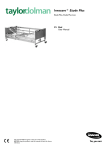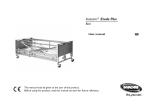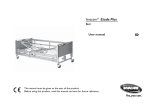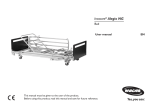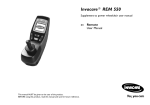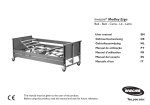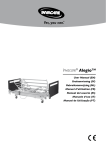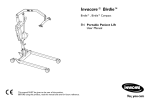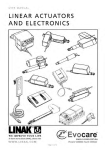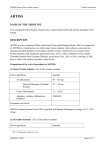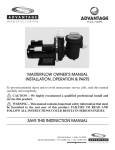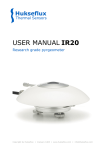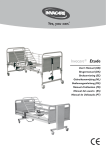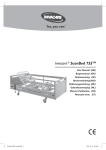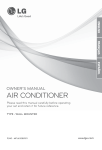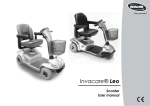Download Etude Plus User Manual
Transcript
Invacare® Etude Plus Etude Plus, Etude Plus Low EN Bed User Manual This manual MUST be given to the user of the product. BEFORE using this product, read this manual and save for future reference. ©2013 Invacare®Corporation All rights reserved. Republication, duplication or modification in whole or in part is prohibited without prior written permission from Invacare. Trademarks are identified by ™and ®. All trademarks are owned by or licensed to Invacare Corporation or its subsidiaries unless otherwise noted. This bed has been tested and approved according to IEC 60601–2–52 (Beds with tilt function can’t be approved according to IEC60601–2–52) This bed has undergone a risk analysis according to EN ISO 14971:2000 Invacare is certified according to ISO 9001 and ISO 13485 Contents 1 General . . . . . . . . . . . . . . . . . . . . . . . . . . . . . . . . . . . . . . . 4 1.1 About this manual . . . . . . . . . . . . . . . . . . . . . . . . . . . 4 1.2 Intended Use . . . . . . . . . . . . . . . . . . . . . . . . . . . . . . . 4 1.3 Service life. . . . . . . . . . . . . . . . . . . . . . . . . . . . . . . . . 4 1.4 Warranty . . . . . . . . . . . . . . . . . . . . . . . . . . . . . . . . . 4 2 Safety. . . . . . . . . . . . . . . . . . . . . . . . . . . . . . . . . . . . . . . . . 5 2.1 General warning . . . . . . . . . . . . . . . . . . . . . . . . . . . . 5 2.2 Labels and symbols on the product . . . . . . . . . . . . . . . 5 3 Setup . . . . . . . . . . . . . . . . . . . . . . . . . . . . . . . . . . . . . . . . . 6 3.1 Receiving the bed. . . . . . . . . . . . . . . . . . . . . . . . . . . . 6 3.2 Assembly of the bed. . . . . . . . . . . . . . . . . . . . . . . . . . 6 3.3 Wiring . . . . . . . . . . . . . . . . . . . . . . . . . . . . . . . . . . . 6 3.4 Dismantle the bed . . . . . . . . . . . . . . . . . . . . . . . . . . . 7 4 Operating the bed . . . . . . . . . . . . . . . . . . . . . . . . . . . . . . 8 4.1 Operating the hand control unit . . . . . . . . . . . . . . . . . 8 4.2 Operating the castor brakes . . . . . . . . . . . . . . . . . . . . 8 4.3 Adjusting the leg section. . . . . . . . . . . . . . . . . . . . . . . 8 4.4 Emergency release of the backrest or thigh/leg section . . . . . . . . . . . . . . . . . . . . . . . . . . . . . . . . . . . 8 5 Accessories . . . . . . . . . . . . . . . . . . . . . . . . . . . . . . . . . . . . 5.1 List of available accessories . . . . . . . . . . . . . . . . . . . . . 5.2 Side rails . . . . . . . . . . . . . . . . . . . . . . . . . . . . . . . . . . Steel side rails . . . . . . . . . . . . . . . . . . . . . . . . . . . . Line and Britt V side rails . . . . . . . . . . . . . . . . . . . . 5.3 Lifting pole . . . . . . . . . . . . . . . . . . . . . . . . . . . . . . . . 5.4 Mattress support extension . . . . . . . . . . . . . . . . . . . . 5.5 Mattress . . . . . . . . . . . . . . . . . . . . . . . . . . . . . . . . . . 5.6 Shipping brackets / Transport brackets . . . . . . . . . . . . 6 Maintenance . . . . . . . . . . . . . . . . . . . . . . . . . . . . . . . . . . . 12 6.1 Maintenance schedule. . . . . . . . . . . . . . . . . . . . . . . . . 12 6.2 Cleaning . . . . . . . . . . . . . . . . . . . . . . . . . . . . . . . . . . 12 7 After Use. . . . . . . . . . . . . . . . . . . . . . . . . . . . . . . . . . . . . . 13 7.1 Waste disposal . . . . . . . . . . . . . . . . . . . . . . . . . . . . . 13 8 Troubleshooting . . . . . . . . . . . . . . . . . . . . . . . . . . . . . . . . 14 8.1 Troubleshooting electrical system . . . . . . . . . . . . . . . . 14 9 Technical data. . . . . . . . . . . . . . . . . . . . . . . . . . . . . . . . . . 9.1 Dimensions . . . . . . . . . . . . . . . . . . . . . . . . . . . . . . . . 9.2 Weights . . . . . . . . . . . . . . . . . . . . . . . . . . . . . . . . . . 9.3 Environmental conditions . . . . . . . . . . . . . . . . . . . . . . 9.4 Electrical system . . . . . . . . . . . . . . . . . . . . . . . . . . . . 9.5 Electromagnetic compliance (EMC) . . . . . . . . . . . . . . . 9 9 9 9 9 10 10 10 11 15 15 15 15 15 16 Etude Plus 1 General 1.1 About this manual Thank you for choosing an Invacare product. This user manual contains important information about the handling of the product. In order to ensure safety when using the product, read the user manual carefully and follow the safety instructions. All indications of right and left are based on a person lying on his back in the bed. Please note that there may be sections in this user manual, which are not relevant to your product, since this manual applies to all existing modules (on the date of printing). Invacare® may repair the fault or replace the component. The warranty provided by Invacare® does not cover additional costs (transport, packaging, labour, sundry expenses, etc. are for the customer’s account). The warranty does not cover: • • • • Damage caused during transport that is not directly reported to the forwarder at the moment of delivery. Repairs performed by unauthorized centers and personnel. Parts subject to normal wear. Malicious damages or damaged caused by improper use of the bed. Symbols in this manual In this User Manual warnings are indicated by symbols. The warning symbols are accompanied by a heading that indicates the severity of the danger. WARNING Indicates a hazardous situation that could result in serious injury or death if it is not avoided. CAUTION Indicates a hazardous situation that could result in minor or slight injury if it is not avoided. IMPORTANT Indicates a hazardous situation that could result in damage to property if it is not avoided. Tips and Recommendations Gives useful tips, recommendations and information for efficient, trouble-free use. This product complies with Directive 93/42/EEC concerning medical devices. The launch date of this product is stated in the CE declaration of conformity. 1.2 Intended Use The bed has been developed for domestic care and features a comfortable sitting and lying position for the patient. Furthermore, ergonomical operation for the carer is ensured. The bed is defined to be used according to: • • Application environment 3; Long-term care in a medical area where medical supervision is required and monitoring is provided if necessary and medical electrical equipment used in medical procedures may be provided to help maintain or improve the condition of the patient. Application environment 4; Care provided in a domestic area where medical electrical equipment is used to alleviate or compensate for an injury, disability or disease. The bed is not intended for children under 12 years and for psychiatric patients. The bed is not intended for transporting the patient. WARNING! Any other or incorrect use could lead to hazardous situations. 1.3 Service life The expected service life of this product is seven years when used daily and in accordance with the safety instructions, maintenance intervals and correct use, stated in this manual. The effective service life can vary according to frequency and intensity of use. 1.4 Warranty The warranty covers all material and production defects for two years from the date of delivery, provided it can be demonstrated that such defects were present before delivery. All manufacturing faults or defects must be promptly reported. 4 1567454-A Safety 2 Safety IMPORTANT! – Do not roll over the mains cable. Do not bring mains cable into moving parts. – Disconnect the plug from the mains before moving the bed. – Make sure that no cables (mains or from other equipment) are jammed or damaged, when the bed is used. – Do not place the bed close to a direct heat source (fire place, radiator etc.) and not in direct sunlight. 2.1 General warning WARNING! Risk of entrapment / suffocation There’s a risk of entrapment / suffocation between mattress support, side rail and bed end – The bed must not be used by patients under 12 years of age, or by patients with body size equivalent to an average 12 years old or smaller. – The bed, in combination with side rails must not be used for persons under 45 kg or under 150 cm height. Either for persons that are restless (spasms) or confused, unless a professional risk assessment has taken place and been accepted. WARNING! Risk due to electromagnetic interference Electromagnetic interference between the bed and other electrical products can occur. – To reduce or eliminate such electromagnetic interference, increase the distance between the bed and the products or switch them off. This medical bed can be used together with medical electrical equipment connected to the heart (intracardially) or blood vessels (intravascularly) provided that following points are respected: – The bed should be equipped with means for potential equalization connection marked out by a symbol shown in the back of this manual. – Medical electrical equipment should not be fixed on the bed’s metallic accessories such as side rails, lifting pole, drip rod, bed ends, etc. – The medical electrical equipment power supply cord should be kept clear of the accessories or any other moving parts of the bed. WARNING! Risk of patients slipping through the openings The bed fulfils all requirements regarding maximum distances. However, it is possible that patients with small body dimensions slip through the openings between the side rails or through the opening between the side rail and the mattress support. – Pay special attention, if the bed is used for the care of patients with small body dimensions. CAUTION! Risk of injury – Always lower the bed to the lowest position before leaving the patient in the bed unattended. – Make sure that there is nothing under, over, or near the bed that can obstruct the height adjustment, like for example furniture, lifts or window frames. – When entering or exiting the bed, use the height adjustment. Use the backrest as support (yellow button on the hand control). The thigh- and leg section must be horizontal, otherwise there is a risk of overloading the mattress support. – There is a risk of entrapment of fingers in the bed moving parts. Pay attention to your fingers. 1567454-A 2.2 Labels and symbols on the product The product-label is placed on the frame of the bed: E A B D C A Type number of the bed B Serial number C Date of production D Electrical information see 9.4 Electrical system, page 15 E Manufacturer Symbols Max. patient weight Max. safe working load Insulation class II Type B Applied Part. See also 9.4 Electrical system, page 15 Refer to the user manual. Waste disposal and recycling information. See 7.1 Waste disposal, page 13. This product complies with Directive 93/42/EEC concerning medical devices. The launch date of this product is stated in the CE declaration of conformity. 5 Etude Plus Mattress support 3 Setup 3.1 Receiving the bed When you receive the bed, check the packaging. If the bed shows any signs of damage upon delivery, please follow terms of delivery A B C D E 000000 000000 000000 000000 000000 000000 000000 000000 000000 000000 00 000000 000000 00 00000000 000000 000000 000000 00 00000000 000000 000000 000000 00 00000000 000000 000000 000000 00 00000000 000000 000000 000000000000 00 00000000 000000 000000 00000000 000000 000000 00 000000 000000 00000000 000000 00 00 000000 00000000000000000000 000000 00 000000 00000000 000000 00 000000 000000 00000000 00 000000 00000000 00 00000000 000000 00000000 000000 00000000 000000 00000000 000000 00000000 000000 00000000 000000 00000000 000000 00000000 000000 000000 000000 000000 000000 000000 00 2. 3. 4. 5. 6. 7. 8. 0000000000000000 0000000000000000 0000000000000000 0000000000000000 0000000000000000 0000000000000000 0000000000000000 0000000000000000 0000000000000000 0000000000000000 0000000000000000 0000000000000000 0000000000000000 0000000000000000 0000000000000000 0000000000000000 0000000000000000 0 00000000 00000000 00000000 00000000 00000000 00000000 00000000 00000000 00000000 00000000 00000000 00000000 00000000 00000000 00000000 00 00 0000 00 0000 0000 00 0000 0000 000 000 00000 00000 000 00 000 000 00 00 0000 0000 000 00 0000 0000 000 00 0000 0000 000 00 0000 0000 000 000 00000 00000 000 00 000 000 00 00 00 0000 0000 000 00 0000 00 0000 0000 000 00 0000 00 00 0000 0000 000 00 0000 0000 000 000 00000 00 0 0 000 00000 00000 000 00 00 00 000 000 00 00 0000 00 000 00000 00000 000 00 0000 00 000 000 00 000 00000 00 000 000 000 0 0 0 0 00000 0000 1. H 0 0 00 0000 00 000 00000 00 000 0 00 G 000000000000 000000000000 F I Place the two inserts in the head end of the mattress support. The inserts must be mounted in such a way that one extends further out of the side tube than the other. Loosely screw in the two thumb screws. Push the foot end of the mattress support onto the two inserts. Tighten with two thumb screws. Retighten the two thumb screws at the head end of the top frame. Turn up the four mattress support brackets. Turn the handle of the leg section up. Press the bracket A on the locking ring* and turn the locking ring on the bed ends to the position "open". J Scope of delivery: A Mattress support, head end B 4 pcs. of mattress support bracket C Pair of side rails (wood or steel) D Mattress support, foot end E Motor for bed end F Castors G Motor for head end I Motor for leg end J Pair of bed ends Hand control 2 9. Latch the mattress support to the bed ends and press firmly into position. 10. Make sure that the bed ends are in the same level. It is possible to level the bed in high position (1) and low position (2). 11. Turn the locking ring to the position "lock". * The locking rings ensure that the mattress support is not accidentally lift clear off the bed ends. Optional H A 1 Mattress support extension (10 or 20 cm) Lifting pole Transport fitting 3.2 Assembly of the bed WARNING! – After each assembly, check that all fittings are tightened correctly and that the function of all parts is given. Control Box The control box is latched to the backrest motor. The control box is provided with a label with symbols showing where to connect the motor plugs: • • • • Backrest motor Thigh section’s motor Bed end motor Hand control 3.3 Wiring IMPORTANT! – The cables must be mounted in such a way that they are kept clear of the floor and do not block the castors. Mount the mains cable on the hook for this purpose, see picture. 6 1567454-A Setup In order to prevent the cables from being torn apart when activating the motors, follow the instructions below. 1. 2. Connect the cables of the bed end motors (head and foot end) directly to the control box. The plug of the thigh motor must be directed through the opening of the supporter for the backrest motor and then be connected to the control box. 3. 4. 5. Connect the main cable plug to the 230 V socket. Run the motors of the bed ends to their top position. Place the motor cable of the foot end on the hook at the foot end. 6. 7. Run the backrest to its top position. Place the head end motor cables on the four hooks at the head end. 8. Fasten the safety clip to the control box. 3.4 Dismantle the bed 1. 2. 3. 4. 5. 6. 7. 8. 9. Dismantle side rails and lifting pole. Bring the bed to its lowest position and adjust all mattress support sections to horizontal position. Disconnect the 230 V supply. Roll the cable onto the hook of the head end of the bed. Disconnect all the motor plugs from the motors (do not disconnect the backrest motor cable). Dismantle the safety comb from the control by means of a tool, e.g. a flat headed screwdriver. Pull out the cables of the bed end motors and leg section motor. Separate the mattress support from the bed ends. Divide the head and foot end of the mattress support. For beds with 24 V external power supply, verify that mains cable is attached to control unit power supply cable. 1567454-A 7 Etude Plus 4 Operating the bed WARNING! Risk of injury – The bed’s castors must be locked whilst nursing a patient in bed or when using any positioning function. – The bed’s castors must be locked when the patient moving in or out of the bed. 4.1 Operating the hand control unit HB80 HL80 HL84 A A A B B B C C C CAUTION! Risk of trapping – Do not release the brake with the fingers. 1. 2. D 1. 2. E p Up q Down A Sitting position B Thight section C Height adjustment of the bed D Tilt function E Key for locking and unlocking the electrical functions Insert the key below each button to respectively lock and unlock the hand control functions. 1. 2. E Use the buttons A to D on the hand control to operate the electrical functions of the bed. Insert the key E below each button and turn it to respectively lock and unlock the hand control functions (hand control unit with locking function only). If the bed is used by restless or confused persons or persons with spasms, the bed should be equipped with a lockable hand control unit to block the hand control functions. Tilt function The bed can be equipped with a hand control (HL84) that activates the tilt of the mattress support. The tilt function is for user’s comfort when sitting in the bed. CAUTION! Risk of injury – Only medically trained persons must operate the tilt function. – The tilt function is NOT a Trendelenburger function and must not be used for medical treatment. – When the tilt function is not needed, lock the tilt function with the key E on the hand control HL84. For braking, step on the pedal For releasing the brake, step on the release pedal Set-off from the castors might under special conditions appear at different types of absorbing floor covering including untreated or badly treated floors. In matters of doubt, it’s recommended to place a suitable kind of protection between the castors and the floor. 4.3 Adjusting the leg section Operate the leg section by lifting the mattress handle: 1. 2. Up: Lift the mattress handle on the leg section. Down: Lift the mattress handle on the leg section right up and then lower the leg section. 4.4 Emergency release of the backrest or thigh/leg section An emergency release of the backrest or thigh/leg section could be necessary in the case of power- or motor failure. CAUTION! Risk of injury – A minimum of two persons are required to release a mattress section. – An emergency release of the height adjustment is NOT possible. – Remove the plug from the mains socket before emergency release of the mattress support. 1. 2. Both persons hold the mattress section. One of them pulls out the cotter pin (from the motor in question). 3. Both persons slowly lower the mattress section until it is completely down. 4.2 Operating the castor brakes Each of the castors is provided with brakes for both lengthwise and crosswise locking. The brakes are foot-operated. When the bed is positioned correctly, at least one castor at the head end and one castor at the foot end must be braked. 8 1567454-A Accessories 5 Accessories Mounting and dismounting 5.1 List of available accessories The side rail must be mounted with the release system at the head end of the bed. • Side rails 1. • • • • • • • – Scala Basic 2 3/4 length collapsible steel side rail (168 cm x 40 cm), mounted on the side tube. Release button in the head section – Scala Basic Plus 2 3/4 length collapsible steel side rail (168 cm x 40 cm), mounted on the side tube. Release button in the head section – Scala Medium 2 3/4 length collapsible steel side rail (165 cm x 46 cm), mounted on the side tube. Release button in the head section – Scala Decubi 2 3/4 length collapsible steel side rail (168 cm x 54 cm), mounted on the side tube. Release button in the head section – Britt V Full length side rail (205 cm x 40 cm) in wood, mounted on the bed end rail. Two centered release buttons for folding of the gate – Line standard Full length side rail (206 cm x 40 cm) in aluminum or wood finish, mounted on the bed end rail. Two centered release buttons for folding of the gate – Line extendable Full length side rail with telescopic extension (206-226 cm x 40 cm) in aluminum or wood finish, mounted on the bed end rail. Two centered release buttons for folding of the gate Mattress support extension – 10 cm Mattress support extension – 20 cm Lifting pole Transport fitting Hand control with tilt, HB84 Hand control with tilt, HL84, with integrated ACP function Backup battery and battery box 2. Operating 1. 1. 2. 2. Up: Lift and pull the top bar of the side rail towards the end with the locking mechanism. Ensure, it is locked in place. Down: Press the release button and push the top bar of the side rail away from the locking mechanism CAUTION! If the side rail is not locked properly it can fall down. – Pull/push the top bar of the side rail to ensure that the locking system is properly engaged. Line and Britt V side rails Important – Use only original accessories and spare parts. Spare parts lists and extra user manuals can be ordered from Invacare or via homepage. WARNING! Risk of entrapment / suffocation – To avoid the patient from entrapping or accidentally falling from the mattress support, it is essential that the gliding shoes are correctly guided into the bed end rails. Adjust the side rail bars by hand, to ensure they are mounted correctly. 5.2 Side rails WARNING! Risk of entrapment or suffocation There’s a risk of entrapment of suffocation between mattress support, side rail and bed end. – Always ensure correct fitting of the side rails. Mounting The fork links on the side rail must be mounted according to the instruction on the side rail. Tighten the side rail with the two finger screws. Dismounting Loosen the two finger screws and remove the steel side rail. Mounting CAUTION! – Make sure that the straps between the rails are not damaged or loose. Steel side rails 1. Mount one end at a time. Lift the upper side rail bar (the release buttons must face up/outwards) 2. 3. Press the locking pin at the end of the side rail with a finger. All three gliding shoes at the end of the bars are guided into the bed end rail, until the lower bar has been locked, thereby preventing the side rail from falling down. 4. Repeat points 2 and 3 when mounting the other end of the side rail. WARNING! Risk of entrapment There’s a risk of entrapment of suffocation between mattress support, side rail and bed end. – When using steel side rails, always make sure that the distance between the bed end and the side rail’s handle upper edge is less than 6 cm in the head end and more than 32 cm in the foot end of the bed. A sticker is placed on the side rail to indicate the minimum space between side rail and the head end of the bed: CAUTION! There’s a risk of entrapment of fingers on assembly and operation of the side rail. 1567454-A 9 Etude Plus Dismounting 1. 2. 3. Lower the side rail. Dismount one end at a time. Lift the lower bar, so that the spring pawl is visible. Press the spring pawl with a key or a screwdriver. 1. 2. 3. Loosen the cord. The lifting handle can now be adjusted to the desired height. Press the cord together and check that the cord is locked in the cord lock by pulling the handle. The distance between the lifting pole and the mattress Minimum (at 16 cm mattress) 36-59 cm Maximum (at 10 cm mattress) 42-65 cm 5.4 Mattress support extension 4. 5. Hold the lower bar. Lower the side rail, until all three bars are free of the bed end rail. Repeat points 2 to 4 when dismounting the other end of the side rail. For patients, taller than two meters it is recommended to use a mattress support extension. Fitting the mattress support extension Operating As a standard, the side rails can only be locked in top position. 1. To lock / raise to upper position: Pull up the top side rail bar, until the locking pin locks with an audible click 1. 2. 2. To release to lower position: Lift the top side rail bar and press the two locking rings together and lower the side rail. Disassemble the bed and remove the inserts. Mount the mattress support extension between both parts of the mattress support and reassemble the bed. 5.5 Mattress WARNING! Safety aspects regarding combination of side rails and mattresses: – In order to obtain the highest possible safety level, when using the bed in combination with side rails, it is important to respect the minimum and maximum measures for mattresses stated in the table. – To mitigate the possibility of the user crawling over the top of the side rail, with the risk of severe injury due to e.g. falling, a minimum vertical distance of 22 cm between the top of the mattress and the top of the side rail are to be respected. The maximum mattress height in combination with a given side rail is stated in the table. – To prevent head entrapment between the inside surface of the side rail and the mattress, with the risk of e.g. suffocation, a safety maximum space has to be respected. When especially very thick mattresses or soft mattresses (low density) or a combination of these it is important to focus on this risk. The minimum width (and length) of mattresses in combination with a given side rail is stated in the table. 5.3 Lifting pole WARNING! Risk of injury If the lifting pole is used while the handle has been turned away from the bed, the bed can tip when the handle is used. – Position the lifting pole in such a way that the handle extends inwards across the bed. Mounting 1. 2. Remove the plug from the lifting pole tube at the head end of the bed where the lifting pole is to be placed. Insert the lifting pole into the lifting pole tube and fix with the thumb screw. Adjusting the height of the lifting pole handle Mattress measures (in cm): Min. height Max. height Min. width Min. length Scala Basic 2 10 17 85 – 90 200 Scala Basic Plus 2 10 17 85 – 90 200 Scala Medium 2 10 22 85 – 90 200 Scala Decubi 2 23 31 85 – 90 200 11 22 88 – 90 200 5 15 88 – 90 200 11 22 85 – 90 200 5 15 85 – 90 200 Side rail: Line*, mattress support platform in low position Line*, mattress support platform in high position Britt V, mattress support platform in low position Britt V, mattress support platform in high position 10 1567454-A Accessories * both Line side rails standard and extendable. 3. Min. density: 38kg/m3 5.6 Shipping brackets / Transport brackets 1. 2. 4. 1567454-A 11 Etude Plus 6 Maintenance 6.1 Maintenance schedule Important – Service and maintenance of the bed must only be performed by personnel who have received the necessary instruction or training. With normal daily use, service must be carried out according to the service schedule after two years of use and thereafter every second year. When relocating the bed, service must be carried out according to the service schedule. Before Use Ensure that all manual and electrical parts are functioning correctly and are in a secure state. After three month Ensure that all manual and electrical parts are functioning, and tighten bolts, screws, nuts, etc. Every two years Service should be performed according to the maintenance chart. See below. Bed / Id. no.: ______________________________________ Date / Initials Visual inspection of all parts of the bed (plastic deformation and/or wear and tear of welded joints) Control all centres of rotation (motors + mattress support parts) Check that all motors are running without failures (with regular speed and at low noise) Check the Rastofix fittings and function Visual inspection of all cabinets for damages. Check that mains cable and plug are intact. Check the running of the cable. Check all remaining cables for damages. Also check the running of the cables. Check of siderails´ fixing and locking/movement. Check the wheels (security, braking and free rolling) Lubrication plan We recommend lubricating the bed according to the following instructions: Lubricate with medically clean oil, e.g. KEN-WO 50: • • • Points of rotation in mattress support and base frame - lubricate with oil. All of the motors’ tension rod - lubricate with oil. All motor bearings and Rastofix fitting - lubricate with oil. The wooden side rails gliding system must not be lubricated with oil - otherwise the wooden bars will move sluggishly. 6.2 Cleaning Important – Make sure the power plug is removed from the socket outlet before cleaning. • • • • • • 12 All plugs must be installed during washing of the bed. The bed should be washed down using a wet sponge, cloth or brush. The bed does not tolerate cleaning in automatic washing plants or the use of water-jet based cleaning equipment. Use ordinary household cleaning agents. Never use acids, alkalines or solvents such as acetone or cellulose thinner. The hand control, motors and control unit may be washed with brush and water, but not with pressurized water. Dry the bed after cleaning. 1567454-A After Use 7 After Use 7.1 Waste disposal This product has been supplied from an environmentally aware manufacturer that complies with the Waste Electrical and Electronic Equipment (WEEE) Directive 2012/19/EU. This product may contain substances that could be harmful to the environment if disposed of in places (landfills) that are not appropriate according to legislation. The »crossed out wheelie bin« symbol is placed on this product to encourage you to recycle wherever possible. Please be environmentally responsible and recycle this product through your recycling facility at its end of life. All wooden parts must be dismantled and sent for incineration. All electric parts must be dismantled and be disposed of as electric components. Plastic parts must be sent for incineration or recycling. Steel parts and castors must be disposed of as waste metals. Waste disposal must comply with the laws and regulations pertaining waste handling in each country. 1567454-A 13 Etude Plus 8 Troubleshooting 8.1 Troubleshooting electrical system Possible cause Remedy Mains is not connected Connect mains Fuse in the control unit is blown Replace the control unit Control unit is defective Replace the control unit Motor plug is not fully inserted into the control unit. Insert the motor plug properly into the control unit The motor is defective. Replace the motor Motor cable is damaged. Replace the cable Control unit is defective Replace the control unit Mains indicator lights up, but the motor is not running. No relay sound is heard from the control unit. Control unit is defective Replace the control unit Hand control is defective Replace the hand control Control unit is in order except for one direction on one channel. Control unit is defective Replace the control unit Hand control is defective Replace the hand control Motor is damaged Replace the motor Symptom Mains indicator does not light up Mains indicator lights up, but the motor is not running. The relay in the control unit makes a clicking noise. Motor is running, but the piston rod does not move. The motor cannot lift full load. Motor noise, but no movement of piston rod. Piston rod operates inwards and not outwards. 14 1567454-A Technical data 9.3 Environmental conditions 9 Technical data Storage Operation and Transportation -10°C to +50°C +5°C to 40°C 9.1 Dimensions All measurements are stated in cm. All angles are stated in degrees. All measurements and angles are stated without tolerances. Temperature Invacare®reserves the right to change the stated measurements and angles. Atmospheric pressure Relative humidity 20% to 75% 800 hPa to 1060 hPa Be aware that when a bed has been stored under low temperatures, it must be adjusted to operating conditions before use. B D 9.4 Electrical system Voltage supply: Uin = 230 Volt, AC, 50 Hz (AC = Alternating current) C Maximum current input: Iin max. = 2 A Intermittent (periodic motor operation): Int = max. 10%, 2 min / 18 min A Degree of protection: IPx6* or IPx4** (depending on configuration) The control unit, external power supply and motors are protected according to IPx6. When the bed is equipped with a HL80 hand control, it is protected according to IPx4 Insulation class: Class II Etude Plus low Etude Plus Low High Low High A 219 219 219 219 B 102 102 102 102 C 20–60 27–67 33–73 40–80 D 138–178 145–185 158–198 165–205 The angle between the lower leg section and horizontal is adjustable from 0º to 15º. Type B Applied Part Applied Part complying with the specified requirements for protection against electrical shock according to IEC60601-1. (An applied parts is a part of the medical equipment which is designed to come into physical contact with the patient or parts that are likely to be brought into contact with the patient.) Sound level: 45 to 50 dB (A) * IPX6 classification means that the electrical system is protected against water projected in powerful jets from any direction. Bed with tilt function ** IPX4 classification means that the electrical system is protected against water splashed against the component from any direction. The bed is not provided with a mains switch, so the mains plug is the only separation from the mains. 9.2 Weights Max. patient weight (provided that the weight of the mattress and the accessories do not exceed 35 kg) 165 kg Max. safe working load (patient + accessories) 200 kg Etude Plus standard bed, complete, excluding accessories Etude Plus auto-regression, complete, excluding accessories Etude Plus bed end with extra plate – 1 piece 77.3 kg Etude Plus bed end without extra plate – 1 piece 17.9 kg Mattress support, standard head end 24.1 kg Mattress support with auto-regression, head end 27.9 kg Mattress support with auto-regression, head end, without actuator and control box Mattress support, foot end 24.1 kg Scala Basic 2 side rail – 1 piece 7.4 kg Lifting pole 4.2 kg Mattress support extension (10 cm) 3.2 kg Mattress support extension (20 cm) 5.5 kg 1567454-A 82.7 kg 20.6 kg 17.4 kg 15 Etude Plus 9.5 Electromagnetic compliance (EMC) Guidance and manufacturer´s declaration – electromagnetic emission The medical bed is intended for use in the electromagnetic environment specified below. The customer or the user of the bed should assure that it is used in such an environment. Emissions test Compliance Electromagnetic environment - guidance RF emissions CISPR 11(partly) Group I The medical bed uses RF energy only for its internal function. Therefore, its RF emissions are very low and are not likely to cause any interference in nearby electronic equipment. RF emissions CISPR 11(partly) Class B The medical bed is suitable for use in all establishments including domestic establishments and those directly connected to the public low-voltage power supply network that supplies buildings used for domestic purposes. Harmonic emissions IEC 61000-3-2 Class A Voltage fluctuations / flicker emissions IEC 61000-3-3 Complies Guidance and manufacturer´s declaration – electromagnetic immunity The medical bed is intended for use in the electromagnetic environment specified below. The customer or the user of the bed should assure that it is used in such an environment. Immunity test IEC 60601 test level Compliance level Electromagnetic environment – guidance Electrostatic discharge (ESD) ± 6 kV contact ± 6 kV contact ± 8 kV air ± 8 kV air Floors should be wood, concrete or ceramic tile. If floors are covered with synthetic material, the relative humidity should be at least 30 %. Electrostatic transient / burst ± 2 kV for power supply lines ± 2 kV for power supply lines IEC 61000-4-4 ± 1 kV for input/output lines ± 1 kV for input/output lines Surge ± 1 kV differential mode ± 1 kV differential mode IEC 61000-4-5 ± 2 kV common mode ± 2 kV common mode < 5% UT (>95% dip in UT) for 0,5 cycle < 5% UT (>95% dip in UT) for 0,5 cycle 40% UT (60% dip in UT ) for 5 cycles 40% UT (60% dip in UT )for 5 cycles 70% UT (30% dip in UT) for 25 cycles 70% UT (30% dip in UT) for 25 cycles < 5% UT (>95% dip in UT) for 5 sec < 5% UT (>95% dip in UT) for 5 sec 3 A/m 3 A/m IEC 61000-4-2 Voltage dips, short interruptions and voltage variations on power supply input lines IEC 61000-4-11 Power frequency (50/60 Hz) magnetic field IEC 61000-4-8 16 Mains power quality should be that of a typical commercial or hospital environment. Mains power quality should be that of a typical commercial or hospital environment. Mains power quality should be that of a typical commercial or hospital environment. If the user of the medical bed requires continued operation during power mains interruptions, it is recommended that the medical bed be powered from an un-interruptible power supply or a battery. UT is the a. c. mains voltage prior to application of the test level. Power frequency magnetic fields should be at levels characteristic of a typical location in a typical commercial or hospital environment. 1567454-A Technical data Portable and mobile RF communications equipment should be used no closer to any part of the medical bed including cables, than the recommended separation distance calculated from the equation applicable to the frequency of the transmitter. Recommended separation distance: Conducted RF IEC 61000-4-6 Radiated RF 3V 3V 3 V/m 3 V/m 80 MHz to 800 MHz IEC 61000-4-3 800 MHz to 2,5 GHz where P is the maximum output power rating of the transmitter in watts (W) according to the transmitter manufacturer and d is the recommended separation distance in metres (m).b Field strengths from fixed RF transmitters, as determined by an electromagnetic site survey,a should be less than the compliance level in each frequency range.b Interference may occur in the vicinity of equipment marked with the following symbol: a Field strengths from fixed transmitters, such as base stations for radio (cellular/cordless) telephones and land mobile radios, amateur radio, AM and FM radio broadcast and TV broadcast cannot be predicted theoretically with accuracy. To assess the electromagnetic environment due to fixed RF transmitters, an electromagnetic site survey should be considered. If the measured field strength in the location in which the medical bed is used exceeds the applicable RF compliance level above, the medical bed should be observed to verify normal operation. If abnormal performance is observed, additional measures may be necessary, such as reorienting or relocating the medical bed. b Over the frequency range 150 kHz to 80 MHz, field strengths should be less than [V1] V/m. At 80 MHz and 800 MHz, the higher frequency range applies. Recommended separation distances between portable and mobile RF communications equipment and the medical bed The medical bed is intended for use in an electromagnetic environment in which radiated RF disturbances are controlled. The customer or the user of the medical bed can help prevent electromagnetic interference by maintaining a minimum distance between portable and mobile RF communications equipment (transmitters) and the medical bed as recommended below, according to the maximum output power of the communications equipment Separation distance according to frequency of transmitter [m] 150 kHz to 80 MHz 80 MHz to 800 MHz 800 MHz to 2,5 GHz 0.01 0.12 0.12 0.23 0.1 0.37 0.37 0.74 1 1.17 1.17 2.33 10 3.69 3.69 7.38 100 11.67 11.67 23.33 Rated maximum output of transmitter [W] For transmitters rated at a maximum output power not listed above the recommended separation, distance d in metres (m) can be estimated using the equation applicable to the frequency of the transmitter, where P is the maximum output power rating of the transmitter in watts (W) according to the transmitter manufacturer. At 80 MHz and 800 MHz, the separation distance for the higher frequency range applies. These guidelines may not apply in all situations. Electromagnetic propagation is affected by absorption and reflection from structures, objects and people. 1567454-A 17 Notes Notes Invacare Sales Companies Ireland: Invacare Ireland Ltd, Unit 5 Seatown Business Campus Seatown Road, Swords, County Dublin Tel : (353) 1 810 7084 Fax: (353) 1 810 7085 [email protected] www.invacare.ie United Kingdom: Invacare Limited Pencoed Technology Park, Pencoed Bridgend CF35 5AQ Tel: (44) (0) 1656 776 222 Fax: (44) (0) 1656 776 220 [email protected] www.invacare.co.uk Manufacturer: Invacare Lda Rua Estrada Velha 949 4465-784 Leça do Balio, Portugal 1567454-A 2013-04-01 *1567454A* Making Life’s Experiences Possible™




















